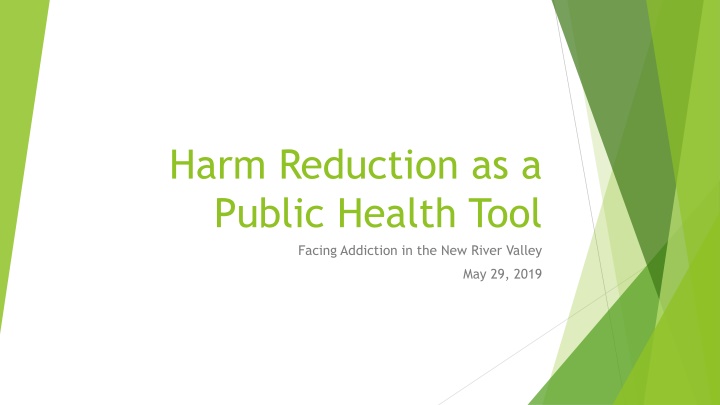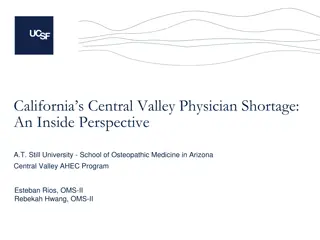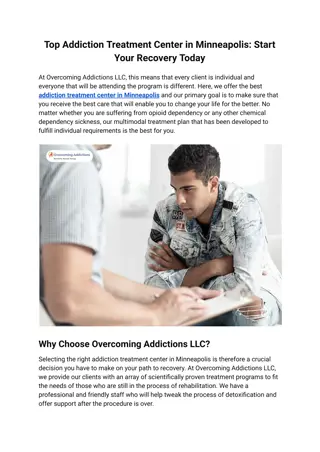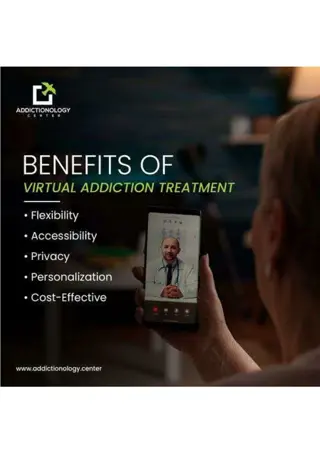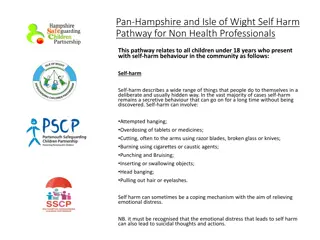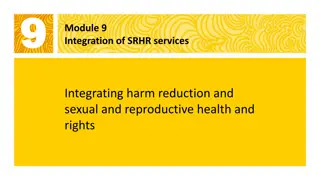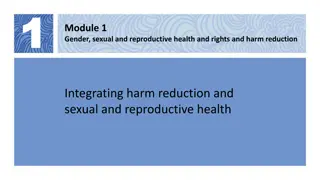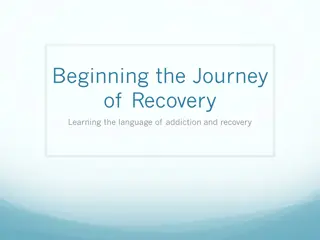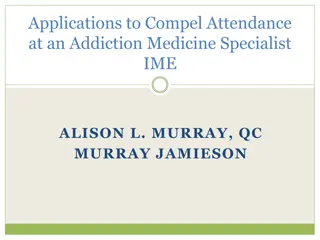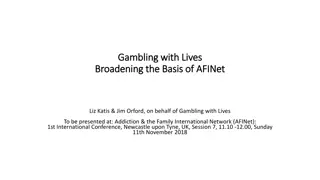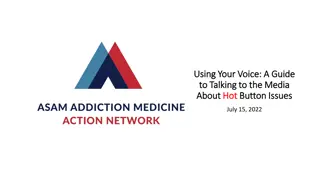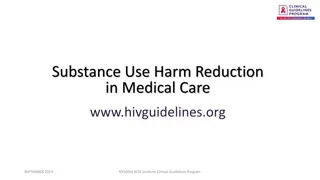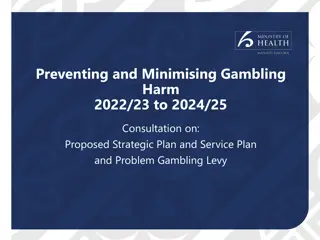Utilizing Harm Reduction for Addressing Addiction in New River Valley
In this presentation, Michael E. Kilkenny discusses the importance of harm reduction as a public health tool in combating addiction issues in the New River Valley. The talk highlights the benefits of harm reduction, components of successful implementation, and measures of program success. It also addresses the pressing problems such as high rates of overdose deaths and drug-related incarceration while emphasizing interventions like naloxone distribution and syringe services. The focus on evidence-based strategies underscores the importance of harm reduction in improving community health outcomes.
Download Presentation

Please find below an Image/Link to download the presentation.
The content on the website is provided AS IS for your information and personal use only. It may not be sold, licensed, or shared on other websites without obtaining consent from the author.If you encounter any issues during the download, it is possible that the publisher has removed the file from their server.
You are allowed to download the files provided on this website for personal or commercial use, subject to the condition that they are used lawfully. All files are the property of their respective owners.
The content on the website is provided AS IS for your information and personal use only. It may not be sold, licensed, or shared on other websites without obtaining consent from the author.
E N D
Presentation Transcript
Harm Reduction as a Public Health Tool Facing Addiction in the New River Valley May 29, 2019
Michael E. Kilkenny, MD, MS Physician Director Cabell-Huntington Health Department 703 7th Ave Huntington, WV 25701 (304) 523-6483 michael.e.kilkenny@wv.gov
Disclosures None
Objectives Participants will be able to list 3 benefits of harm reduction Participants will be able to list 2 components of successful harm reduction implementation Participants will be able to list 2 measures of harm reduction program success
The Problems High Rates of Overdose Death High Rates of Hepatitis B High Rates of Hepatitis C High Risk of HIV Outbreak High Rates of Neonatal Opioid Withdrawal Syndrome High Rates of Drug-related Incarceration High Rates of Utilization of Foster Care
So, What Helps? Top of the Pyramid Naloxone Syringe Services User Education Disease Testing Referral and Treatment (These are All Elements of Harm Reduction)
What Else Helps? Middle of the Pyramid Immunizations Public Education Prescription Drug Monitoring Programs Good Samaritan Laws
More Things that Help Bottom of the Pyramid Higher High School Completion Rates Economic Development
Now Lets Focus on Harm Reduction * = Evidence Based Intervention Naloxone Targeted Naloxone Distribution* Community Naloxone Distribution Persons at high risk of witnessing overdose First Responders EMS, Police, Fire, Outreach Co-prescribing Persons prescribed high dose opioids
Remember, * = Evidence Based Intervention Syringe Services* Syringe Service participants are 5 times more likely to enter drug treatment and 3.5 times more likely to cease injecting than those who don t. Effective in reducing the spread of hepatitis C, hepatitis B, and HIV. Serve as a resource for clinicians, law enforcement, judicial system programs and social programs.
Did you say something about Education? Education of Users Education of injection drug users can alter their drug using behaviors.* Fentanyl testing and education can reduce overdose risk. Harm reduction clients frequently express appreciation of education regarding infection risk, skin care, injection technique, infection treatment. Education regarding substance use treatment options can encourage Medication Assisted Treatment*
How does Disease Testing Help? Disease Testing The Cabell-Huntington Harm Reduction Program provides opt-out testing of new clients and 3 month reminders for repeat testing for HIV negative clients. CHHRP offers time of visit STD testing for most harm reduction visits.
Referral CHHD offers referral for disease management for HIV, hepatitis, and other complications of injection drug use when present. CHHD offers Pre-Exposure Prophylaxis against HIV on-site. During a 9 month period in 2018, CHHRP referred more clients to substance use treatment (including MAT*) than it accepted as new clients.
Setting up Harm Reduction Review Applicable HRP Guidelines and Certification Procedures. Assess Community Need and Readiness Build Community Support Address Waste Management for Syringe Disposal
Community Need and Readiness Review community level data Vital Statistics Reports Other health reports Local experts Law enforcement, prosecuting attorneys, drug courts, EMS, Emergency departments, infectious disease specialists, county health departments, drug user unions
Address medical waste requirements If you provide syringe services and accept returned syringes, you will have to assess your medical waste status and likely adjust it to Large Producer. Review your waste management certification and requirements. CHHRP s process required staged approvals and public notification periods. This can take 90 days or more. CHHRP provides and collects thousands of pounds of syringes. What would your program handle?
The Results Can Be AMAZING! Community partnerships are formed and strengthened. Political support can be gained. Workforce can be energized. Client engagement can be rewarding. Outcomes are visible.
Acute Hepatitis C, Cabell County, WV, 2013-2018* 12 10 Change in case definition 8 6 4 2 0 2014 2015 2016 2017 Incidence per 100,000 Incidence Assoc With IDU Data Source: Cabell-Huntington Health Department * 2018 Data preliminary through August 20, 2018
Local Overdose Death Trends Overdose Death Occurrence, Cabell County, WV, 2017* 30 25 20 15 10 5 0 Jan, '17 Feb, '17 Mar, '17 Apr, '17 May, '17 Jun, '17 Jul, '17 Aug, '17 Sep, '17 Oct, '17 Nov, '17 Dec, '17 Deaths Linear (Deaths) Data Source: WV Health Statistics Center, 08/15/2018 Update. *Data Preliminary and incomplete. Care should be taken regarding conclusions drawn from preliminary data.
Resources Centers for Disease Control and Prevention. Evidence-Based Strategies for Preventing Opioid Overdose: What s Working in the United States. National Center for Injury Prevention and Control, Centers for Disease Control and Prevention, U.S. Department of Health and Human Services, 2018. Accessed [date] from http://www. cdc.gov/drugoverdose/pdf/pubs/2018-evidence-based-strategies.pdf Sherman, S.G., Park, J.N., Glick, J., McKenzie, M., Morales, K., Christensen, T., Green, T.C. (2018) FORECAST Study Summary Report. Johns Hopkins Bloomberg School of Public Health. https://harmreduction.org https://dhhr.wv.gov/oeps/harm-reduction/Pages/default.aspx https://dhhr.wv.gov/oeps/harm- reduction/Documents/AUGUST%202018%20CERTIFICATION%20GUIDELINES_FINAL.pdf
